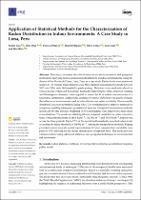Application of Statistical Methods for the Characterization of Radon Distribution in Indoor Environments: A Case Study in Lima, Peru

View/
Author(s)
Liza, Rafael
Díaz, Félix
Pereyra, Patrizia
Palacios, Daniel
Cerna, Nhell
Curo, Luis
Riva, Max
Date
2025-02-12Metadata
Show full item recordPublisher
MDPI
Journal
Eng
Abstract
This study evaluates the effectiveness of advanced statistical and geospatial methods for analyzing radon concentration distributions in indoor environments, using the district of San Martín de Porres, Lima, Peru, as a case study. Radon levels were monitored using LR-115 nuclear track detectors over three distinct measurement periods between 2015 and 2016, with 86 households participating. Detectors were randomly placed in various rooms within each household. Normality tests (Shapiro–Wilk, Anderson–Darling, and Kolmogorov–Smirnov) were applied to assess the fit of radon concentrations to a log-normal distribution. Additionally, analysis of variance (ANOVA) was used to evaluate the influence of environmental and structural factors on radon variability. Non-normally distributed data were normalized using a Box–Cox transformation to improve statistical assumptions, enabling subsequent geostatistical analyses. Geospatial interpolation methods, specifically Inverse Distance Weighting (IDW) and Kriging, were employed to map radon concentrations. The results revealed significant temporal variability in radon concentrations, with geometric means of 146.4 Bq·m−3 , 162.3 Bq·m−3 , and 150.8 Bq·m−3 , respectively, across the three periods. Up to 9.5% of the monitored households recorded radon levels exceeding the safety threshold of 200 Bq·m−3 . Among the interpolatio methods, Kriging provided a more accurate spatial representation of radon concentration variability compared to IDW, allowing for the precise identification of high-risk areas. This study provides a framework for using advanced statistical and geospatial techniques in environmental risk assessment.
Type
info:eu-repo/semantics/article
Rights
info:eu-repo/semantics/openAccess
Language
eng
Collections
- Ingeniería Civil [8]

